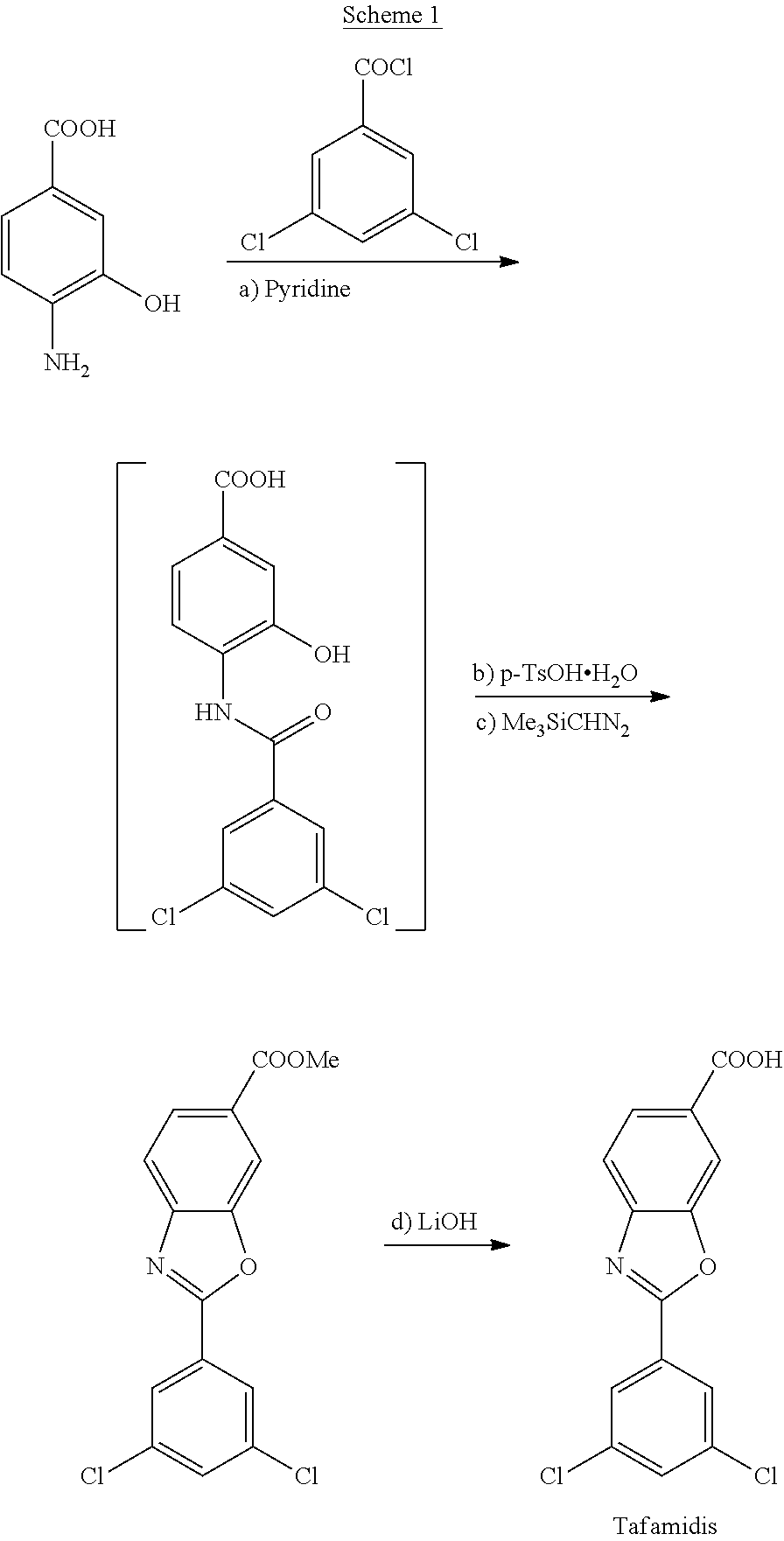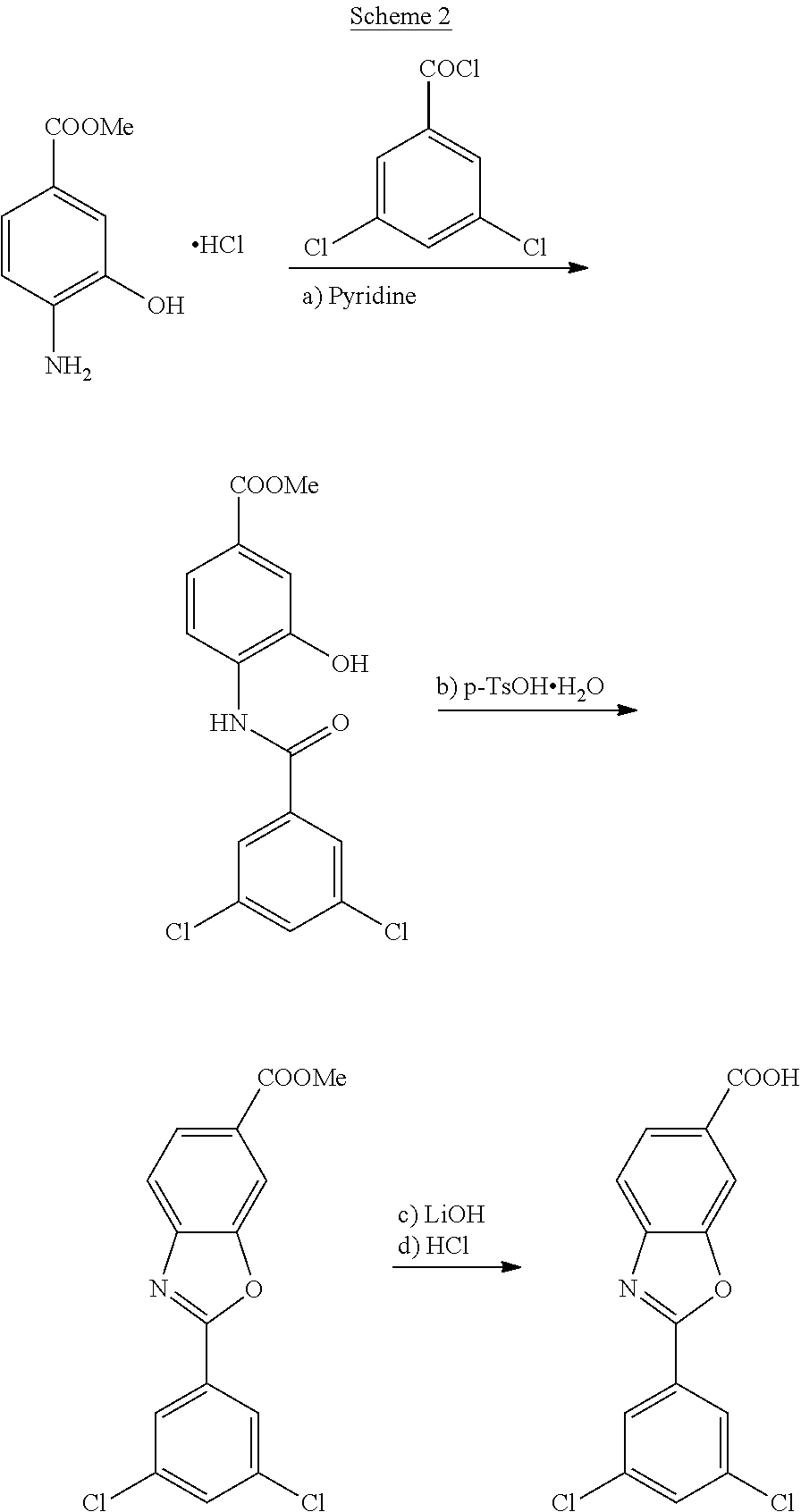Process for Preparing 1-deoxy-1-methylamino-D-glucitol 2-(3,5-dichlorophenyl)-6-benzoxazolecarboxylate
a technology of methylamino-d-glucitol and process, which is applied in the field of improving the process for the preparation of 1deoxy-1methylamino-d-glucitol 2(3, 5dichlorophenyl)6benzoxazolecarboxylate, can solve the problems of unsuitable industrial scale applications, and unsuitable for industrial scale applications. , to achieve the effect of high yield, high purity and efficien
- Summary
- Abstract
- Description
- Claims
- Application Information
AI Technical Summary
Benefits of technology
Problems solved by technology
Method used
Image
Examples
reference example 1
yl 4-(3,5-dichlorobenzamido)-3-hydroxybenzoate
[0126]To a suspension of methyl 4-amino-3-hydroxybenzoate (2.0 g, 12.0 mmol) in dry CH2Cl2 (20 mL) was added, at a temperature of 20-25° C., pyridine (1.2 mL, 15.0 mmol). The mixture was cooled down to a temperature of 0-5 ° C. and maintained for 15 min. Then, a solution of 3,5-dichlorobenzoyl chloride (2.7 g, 12.6 mmol) was added. The resulting suspension was warmed at a temperature of 20-25° C. and the reaction was stirred for 16 hours. Once the reaction was finished, the thick suspension was filtered and washed with CH2Cl2. The obtained brown solid was suspended in a mixture of acetone / H2O and the slurry was stirred for an hour at room temperature; the solid was filtered, washed with a mixture of acetone and water and dried in an air-oven at 45° C. affording methyl 4-(3,5-dichlorobenzamido)-3-hydroxybenzoate (2.46 g, 7.2 mmol) as a light brown solid which was slightly impurified by TLC.[0127]Yield: 60%
example 1
of methyl 4-(3,5-dichlorobenzamido)-3-hydroxybenzoate
[0128]To a suspension of methyl 4-amino-3-hydroxybenzoate (50.0 g, 300 mmol) in of dry THF (400 mL) was added, at a temperature of 20-25° C., NaHCO3 (27.6 g, 330 mmol). The mixture was cooled down to a temperature of 10-15° C. and a solution of 3,5-dichlorobenzoyl chloride (65.8 g, 314 mmol) in of dry THF (100 mL) was added dropwise maintaining the internal temperature below 20° C. Then, the temperature was adjusted to 20-25° C. and the reaction mixture was stirred for 16 hours. Once the reaction was finished, the solvent was vacuum distilled, and the resulting crude was resuspended in 500 mL of a mixture of acetone (250 mL) and water (250 mL). The thick suspension was stirred at room temperature for an hour and at 0-5° C. for an hour more. The obtained solid was filtered, washed with a mixture of acetone and water, and dried in an air-oven at 45° C. affording methyl 4-(3,5-dichlorobenzamido)-3-hydroxybenzoate (93.4 g, 275 mmol) a...
example 2
of methyl 2-(3,5-dichlorophenyl)benzo[d]oxazole-6-carboxylate
[0130]p-Toluenesulfonic acid monohydrate (4.5 g, 23.52 mmol) was added to a suspension of methyl 4-(3,5-dichlorobenzamido)-3-hydroxybenzoate (80 g, 235.2 mmol), obtained in example 1, in toluene (1,6 L). The resulting mixture was heated at reflux and the reaction was stirred for 16 hours with elimination of water. The solution was cooled down to 45° C. and filtered. Solvent was vacuum distilled, and the resulting crude was resuspended in acetone (560 mL) and water (80 mL). The resulting thick suspension was stirred at room temperature for an hour, the solid was filtered, washed with a mixture of acetone and water and dried in an air-oven at 45° C. furnishing methyl 2-(3,5-dichlorophenyl)benzo[d]oxazole-6-carboxylate (70.0 g, 217.0 mmol) as a slightly brown solid.[0131]Yield: 92.4%
PUM
| Property | Measurement | Unit |
|---|---|---|
| temperature | aaaaa | aaaaa |
| temperature | aaaaa | aaaaa |
| temperature | aaaaa | aaaaa |
Abstract
Description
Claims
Application Information
 Login to View More
Login to View More - R&D
- Intellectual Property
- Life Sciences
- Materials
- Tech Scout
- Unparalleled Data Quality
- Higher Quality Content
- 60% Fewer Hallucinations
Browse by: Latest US Patents, China's latest patents, Technical Efficacy Thesaurus, Application Domain, Technology Topic, Popular Technical Reports.
© 2025 PatSnap. All rights reserved.Legal|Privacy policy|Modern Slavery Act Transparency Statement|Sitemap|About US| Contact US: help@patsnap.com



